Abstract
Quinolone antibiotics have been proposed as possible alternatives to vancomycin for methicillin-resistant Staphylococcus aureus infections. We investigated the activities of amifloxacin, ciprofloxacin, norfloxacin, and vancomycin by time-kill kinetic studies. Antibiotic concentrations of 0, 1.0, and 4.0 times the MIC were used against four strains of gentamicin- and methicillin-resistant S. aureus. Staphylococci were plated onto ciprofloxacin-containing agar at all time points, in repeat time-kill kinetic studies. Macrobroth dilution MICs and MBCs were determined. Ciprofloxacin levels were measured by bioassay. Replica plating was performed from the original susceptible inoculum (MIC, 0.125 micrograms/ml) onto ciprofloxacin-supplemented agar. At 4.0 times the MIC, only with ciprofloxacin was there regrowth at 24 and 48 h. All four strains of staphylococci grew on agar supplemented with 1 microgram of ciprofloxacin per ml; three of four grew on agar supplemented with 2 micrograms of ciprofloxacin per ml. MICs and MBCs for these resistant clones ranged from 8 to 32 micrograms/ml. No degradation in activity or amount of ciprofloxacin could be detected in the bioassay. Replica-plated staphylococci grew on agar containing 1 microgram/ml but not higher concentrations of ciprofloxacin at 48 h. Amifloxacin and norfloxacin sustained bactericidal activity comparable to that of vancomycin. We conclude that heteroresistant subpopulations of gentamicin- and methicillin-resistant S. aureus can emerge under antibiotic selection pressure. Such resistant clones may then mutate in the presence of subinhibitory concentrations of antibiotic to higher levels of ciprofloxacin resistance.
Full text
PDF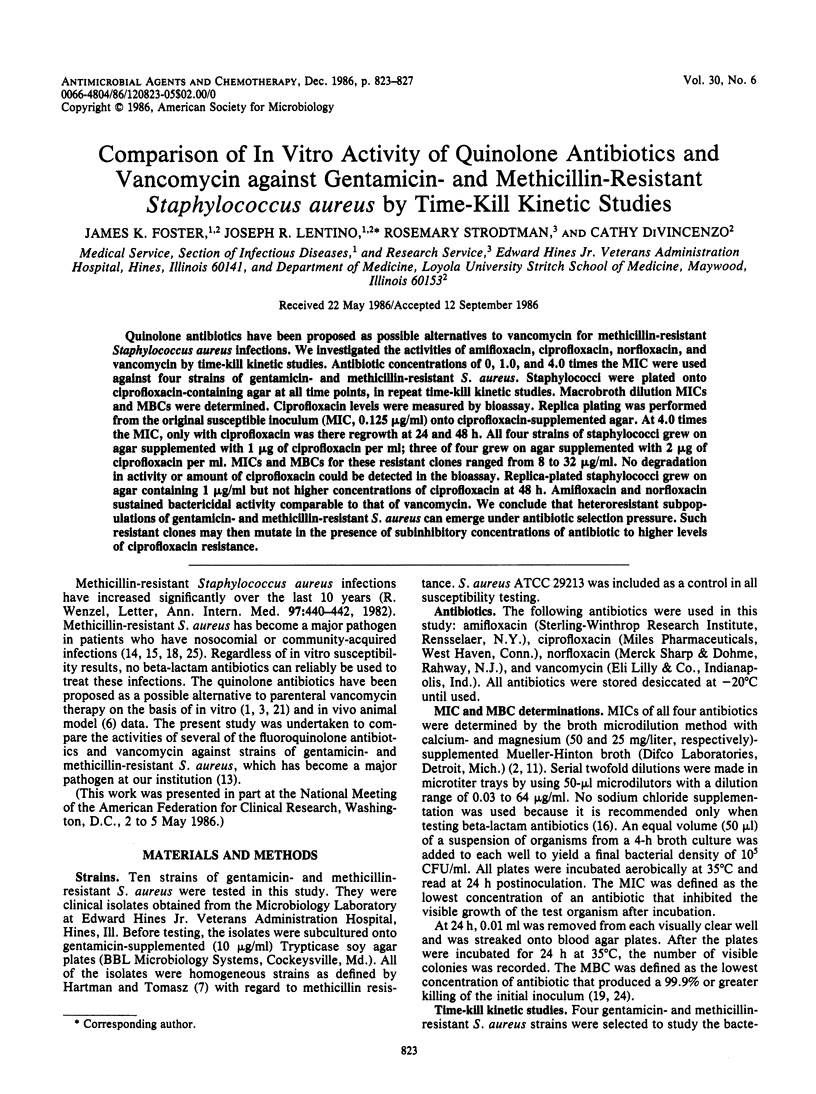
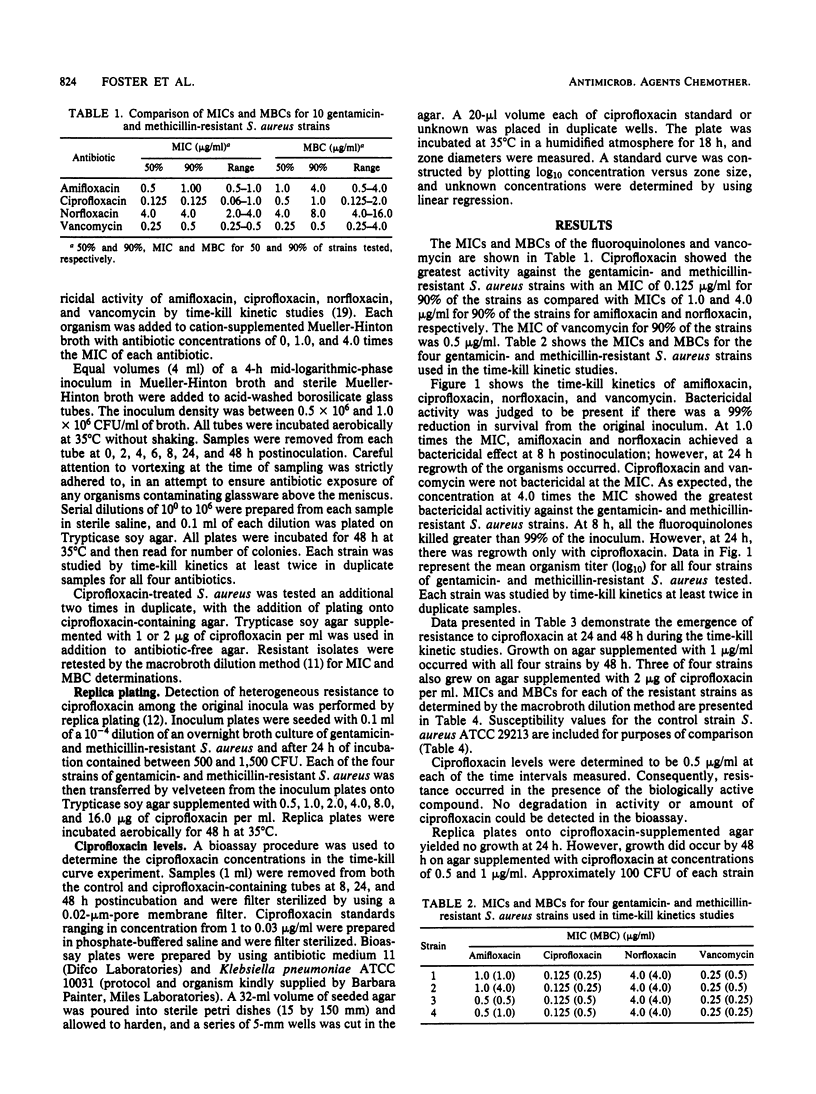
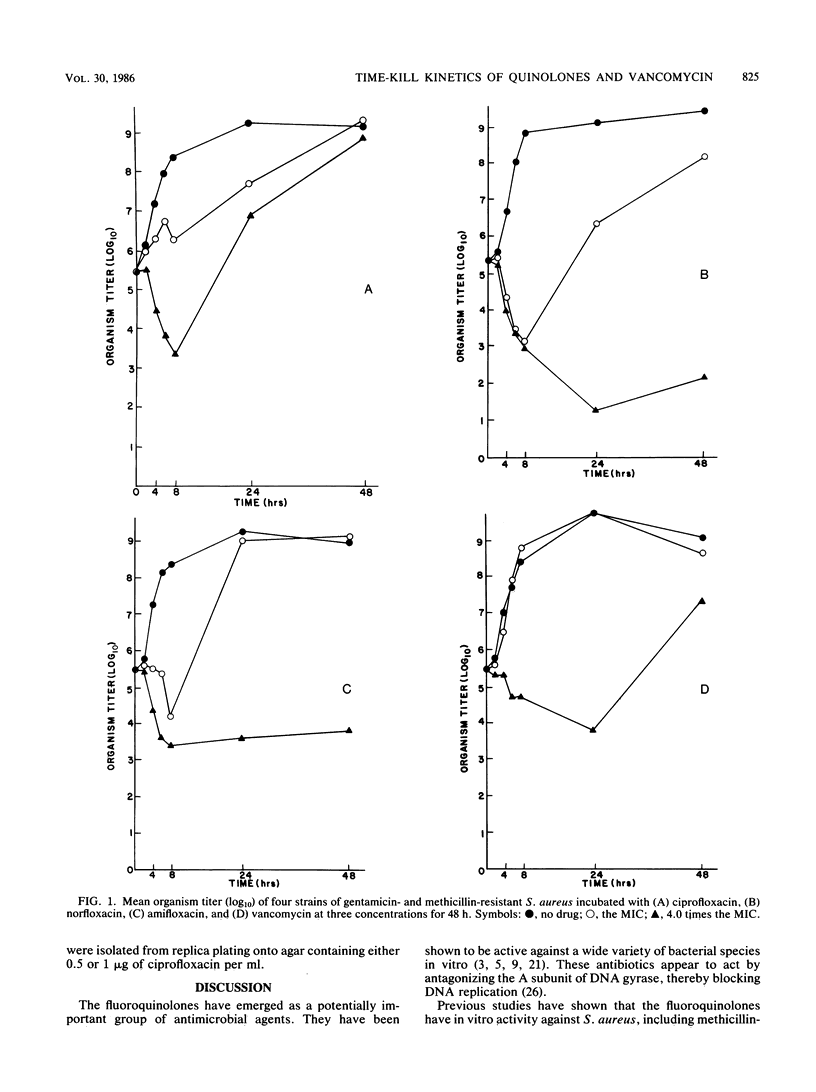
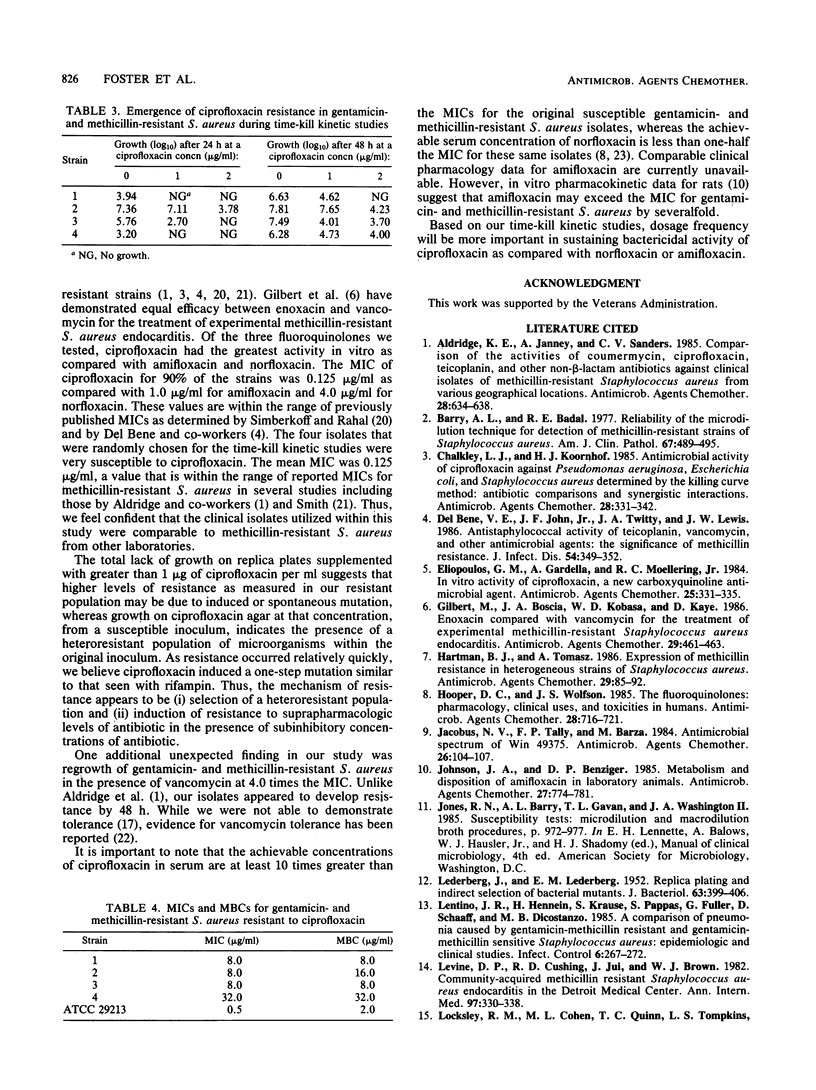
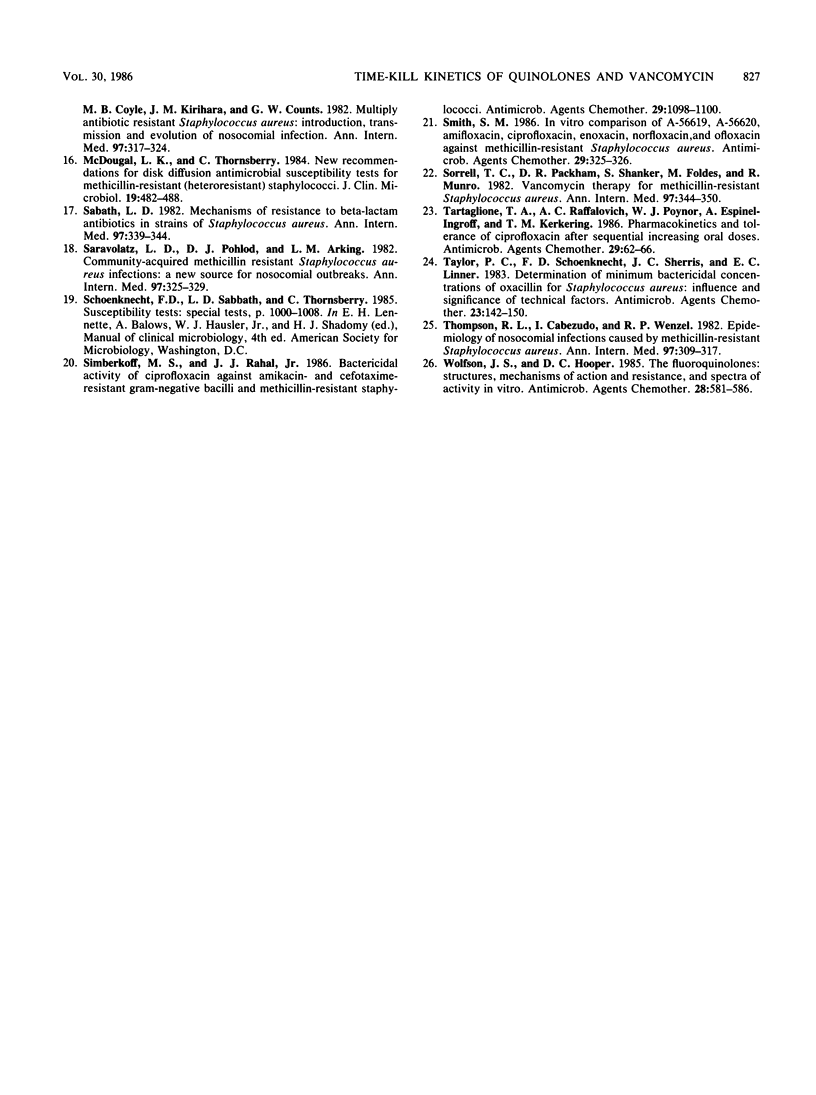
Selected References
These references are in PubMed. This may not be the complete list of references from this article.
- Aldridge K. E., Janney A., Sanders C. V. Comparison of the activities of coumermycin, ciprofloxacin, teicoplanin, and other non-beta-lactam antibiotics against clinical isolates of methicillin-resistant Staphylococcus aureus from various geographical locations. Antimicrob Agents Chemother. 1985 Nov;28(5):634–638. doi: 10.1128/aac.28.5.634. [DOI] [PMC free article] [PubMed] [Google Scholar]
- Barry A. L., Badal R. E. Reliability of the microdilution technic for detection of methicillin-resistant strains of staphylococcus aureus. Am J Clin Pathol. 1977 May;67(5):489–495. doi: 10.1093/ajcp/67.5.489. [DOI] [PubMed] [Google Scholar]
- Chalkley L. J., Koornhof H. J. Antimicrobial activity of ciprofloxacin against Pseudomonas aeruginosa, Escherichia coli, and Staphylococcus aureus determined by the killing curve method: antibiotic comparisons and synergistic interactions. Antimicrob Agents Chemother. 1985 Aug;28(2):331–342. doi: 10.1128/aac.28.2.331. [DOI] [PMC free article] [PubMed] [Google Scholar]
- Del Bene V. E., John J. F., Jr, Twitty J. A., Lewis J. W. Anti-staphylococcal activity of teicoplanin, vancomycin, and other antimicrobial agents: the significance of methicillin resistance. J Infect Dis. 1986 Aug;154(2):349–352. doi: 10.1093/infdis/154.2.349. [DOI] [PubMed] [Google Scholar]
- Eliopoulos G. M., Gardella A., Moellering R. C., Jr In vitro activity of ciprofloxacin, a new carboxyquinoline antimicrobial agent. Antimicrob Agents Chemother. 1984 Mar;25(3):331–335. doi: 10.1128/aac.25.3.331. [DOI] [PMC free article] [PubMed] [Google Scholar]
- Gilbert M., Boscia J. A., Kobasa W. D., Kaye D. Enoxacin compared with vancomycin for the treatment of experimental methicillin-resistant Staphylococcus aureus endocarditis. Antimicrob Agents Chemother. 1986 Mar;29(3):461–463. doi: 10.1128/aac.29.3.461. [DOI] [PMC free article] [PubMed] [Google Scholar]
- Hartman B. J., Tomasz A. Expression of methicillin resistance in heterogeneous strains of Staphylococcus aureus. Antimicrob Agents Chemother. 1986 Jan;29(1):85–92. doi: 10.1128/aac.29.1.85. [DOI] [PMC free article] [PubMed] [Google Scholar]
- Hooper D. C., Wolfson J. S. The fluoroquinolones: pharmacology, clinical uses, and toxicities in humans. Antimicrob Agents Chemother. 1985 Nov;28(5):716–721. doi: 10.1128/aac.28.5.716. [DOI] [PMC free article] [PubMed] [Google Scholar]
- Jacobus N. V., Tally F. P., Barza M. Antimicrobial spectrum of Win 49375. Antimicrob Agents Chemother. 1984 Jul;26(1):104–107. doi: 10.1128/aac.26.1.104. [DOI] [PMC free article] [PubMed] [Google Scholar]
- Johnson J. A., Benziger D. P. Metabolism and disposition of amifloxacin in laboratory animals. Antimicrob Agents Chemother. 1985 May;27(5):774–781. doi: 10.1128/aac.27.5.774. [DOI] [PMC free article] [PubMed] [Google Scholar]
- LEDERBERG J., LEDERBERG E. M. Replica plating and indirect selection of bacterial mutants. J Bacteriol. 1952 Mar;63(3):399–406. doi: 10.1128/jb.63.3.399-406.1952. [DOI] [PMC free article] [PubMed] [Google Scholar]
- Lentino J. R., Hennein H., Krause S., Pappas S., Fuller G., Schaaff D., DiCostanzo M. B. A comparison of pneumonia caused by gentamicin, methicillin-resistant and gentamicin, methicillin-sensitive Staphylococcus aureus: epidemiologic and clinical studies. Infect Control. 1985 Jul;6(7):267–272. doi: 10.1017/s0195941700061737. [DOI] [PubMed] [Google Scholar]
- Levine D. P., Cushing R. D., Jui J., Brown W. J. Community-acquired methicillin-resistant Staphylococcus aureus endocarditis in the Detroit Medical Center. Ann Intern Med. 1982 Sep;97(3):330–338. doi: 10.7326/0003-4819-97-3-330. [DOI] [PubMed] [Google Scholar]
- Locksley R. M., Cohen M. L., Quinn T. C., Tompkins L. S., Coyle M. B., Kirihara J. M., Counts G. W. Multiply antibiotic-resistant Staphylococcus aureus: introduction, transmission, and evolution of nosocomial infection. Ann Intern Med. 1982 Sep;97(3):317–324. doi: 10.7326/0003-4819-97-3-317. [DOI] [PubMed] [Google Scholar]
- McDougal L. K., Thornsberry C. New recommendations for disk diffusion antimicrobial susceptibility tests for methicillin-resistant (heteroresistant) staphylococci. J Clin Microbiol. 1984 Apr;19(4):482–488. doi: 10.1128/jcm.19.4.482-488.1984. [DOI] [PMC free article] [PubMed] [Google Scholar]
- Sabath L. D. Mechanisms of resistance to beta-lactam antibiotics in strains of Staphylococcus aureus. Ann Intern Med. 1982 Sep;97(3):339–344. doi: 10.7326/0003-4819-97-3-339. [DOI] [PubMed] [Google Scholar]
- Saravolatz L. D., Pohlod D. J., Arking L. M. Community-acquired methicillin-resistant Staphylococcus aureus infections: a new source for nosocomial outbreaks. Ann Intern Med. 1982 Sep;97(3):325–329. doi: 10.7326/0003-4819-97-3-325. [DOI] [PubMed] [Google Scholar]
- Simberkoff M. S., Rahal J. J., Jr Bactericidal activity of ciprofloxacin against amikacin- and cefotaxime-resistant gram-negative bacilli and methicillin-resistant staphylococci. Antimicrob Agents Chemother. 1986 Jun;29(6):1098–1100. doi: 10.1128/aac.29.6.1098. [DOI] [PMC free article] [PubMed] [Google Scholar]
- Smith S. M. In vitro comparison of A-56619, A-56620, amifloxacin, ciprofloxacin, enoxacin, norfloxacin, and ofloxacin against methicillin-resistant Staphylococcus aureus. Antimicrob Agents Chemother. 1986 Feb;29(2):325–326. doi: 10.1128/aac.29.2.325. [DOI] [PMC free article] [PubMed] [Google Scholar]
- Sorrell T. C., Packham D. R., Shanker S., Foldes M., Munro R. Vancomycin therapy for methicillin-resistant Staphylococcus aureus. Ann Intern Med. 1982 Sep;97(3):344–350. doi: 10.7326/0003-4819-97-3-344. [DOI] [PubMed] [Google Scholar]
- Tartaglione T. A., Raffalovich A. C., Poynor W. J., Espinel-Ingroff A., Kerkering T. M. Pharmacokinetics and tolerance of ciprofloxacin after sequential increasing oral doses. Antimicrob Agents Chemother. 1986 Jan;29(1):62–66. doi: 10.1128/aac.29.1.62. [DOI] [PMC free article] [PubMed] [Google Scholar]
- Taylor P. C., Schoenknecht F. D., Sherris J. C., Linner E. C. Determination of minimum bactericidal concentrations of oxacillin for Staphylococcus aureus: influence and significance of technical factors. Antimicrob Agents Chemother. 1983 Jan;23(1):142–150. doi: 10.1128/aac.23.1.142. [DOI] [PMC free article] [PubMed] [Google Scholar]
- Thompson R. L., Cabezudo I., Wenzel R. P. Epidemiology of nosocomial infections caused by methicillin-resistant Staphylococcus aureus. Ann Intern Med. 1982 Sep;97(3):309–317. doi: 10.7326/0003-4819-97-3-309. [DOI] [PubMed] [Google Scholar]
- Wolfson J. S., Hooper D. C. The fluoroquinolones: structures, mechanisms of action and resistance, and spectra of activity in vitro. Antimicrob Agents Chemother. 1985 Oct;28(4):581–586. doi: 10.1128/aac.28.4.581. [DOI] [PMC free article] [PubMed] [Google Scholar]


